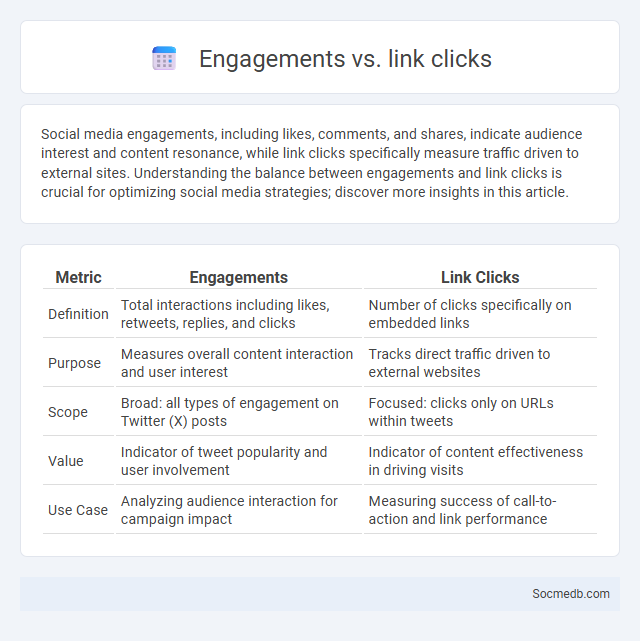
Photo illustration: Engagements vs link clicks
Social media engagements, including likes, comments, and shares, indicate audience interest and content resonance, while link clicks specifically measure traffic driven to external sites. Understanding the balance between engagements and link clicks is crucial for optimizing social media strategies; discover more insights in this article.
Table of Comparison
| Metric | Engagements | Link Clicks |
|---|---|---|
| Definition | Total interactions including likes, retweets, replies, and clicks | Number of clicks specifically on embedded links |
| Purpose | Measures overall content interaction and user interest | Tracks direct traffic driven to external websites |
| Scope | Broad: all types of engagement on Twitter (X) posts | Focused: clicks only on URLs within tweets |
| Value | Indicator of tweet popularity and user involvement | Indicator of content effectiveness in driving visits |
| Use Case | Analyzing audience interaction for campaign impact | Measuring success of call-to-action and link performance |
Understanding Engagements: Definition and Importance
Engagements on social media refer to user interactions such as likes, comments, shares, and clicks that indicate audience involvement with content. High engagement rates boost algorithmic visibility, amplifying reach and fostering brand loyalty. Measuring engagements provides valuable insights into audience preferences, enabling optimized content strategies for greater impact.
Link Clicks: What Counts and Why They Matter
Link clicks measure the number of times users interact with hyperlinks in social media posts, directing traffic to external content such as websites, blogs, or product pages. This metric is crucial for evaluating audience engagement, campaign effectiveness, and the success of call-to-action strategies in digital marketing. High link click rates often correlate with increased conversions, brand awareness, and return on investment (ROI).
Decoding Engagements vs. Link Clicks
Understanding the difference between social media engagements and link clicks is crucial for optimizing your digital strategy. Engagements encompass likes, comments, shares, and reactions, indicating how users interact with your content emotionally or socially, while link clicks measure direct traffic driven to your website or landing page. To improve your campaign effectiveness, focus on interpreting these metrics together, as high engagement can amplify reach, but link clicks directly influence conversions and sales.
The Role of Reports in Digital Marketing Metrics
Reports play a crucial role in digital marketing metrics by providing detailed insights into campaign performance, audience engagement, and conversion rates across various social media platforms. These analytics help you identify which strategies are most effective, allowing for data-driven adjustments that enhance ROI and overall brand visibility. Effective reporting tools aggregate metrics such as click-through rates, impressions, and follower growth to deliver a comprehensive view of your digital marketing success.
Comparative Analysis: Engagements vs. Link Clicks
Social media engagement metrics, such as likes, comments, and shares, often exhibit higher volumes compared to link clicks, which are more indicative of direct user actions towards conversion goals. Engagements reflect audience interaction and content resonance, while link clicks provide concrete data on traffic generation and potential customer intent. Analyzing the ratio of engagements to link clicks enhances marketing strategies by identifying content effectiveness in driving both brand awareness and measurable website visits.
Interpreting Social Media Reports Effectively
Interpreting social media reports effectively requires analyzing key metrics such as engagement rates, reach, and sentiment to understand audience behavior and campaign performance. You can leverage tools like Google Analytics and native platform insights to identify trends and optimize content strategies. Accurate interpretation ensures data-driven decisions that enhance brand visibility and drive user interaction across platforms.
Key Metrics: When to Focus on Engagements
Focusing on engagements is crucial when measuring social media effectiveness in campaigns aimed at building community and enhancing brand loyalty. Metrics such as likes, comments, shares, and saves indicate audience interaction and content relevance. High engagement rates often signal successful content strategies that foster authentic connections and drive organic reach.
When Link Clicks Drive Campaign Success
Link clicks are a critical metric in social media campaigns, directly influencing conversion rates and overall ROI. Tracking user engagement through link clicks helps marketers identify which content and platforms yield the highest audience interest and drive traffic effectively. Optimizing campaigns to increase link clicks enhances lead generation and supports targeted advertising strategies for sustained success.
Integrating Report Data for Strategic Decision-Making
Integrating report data from social media platforms enables you to harness valuable insights such as engagement metrics, audience demographics, and content performance. Leveraging this data facilitates informed strategic decision-making, optimizing marketing campaigns and enhancing brand visibility. Access to real-time analytics empowers businesses to adjust strategies promptly, driving improved ROI and customer targeting precision.
Choosing the Right Metric for Your Marketing Goals
Selecting the appropriate social media metric depends on your specific marketing goals, whether it's brand awareness, engagement, or conversion rates. For brand awareness, prioritize reach and impressions to measure audience size and exposure. When focusing on engagement, track metrics such as likes, comments, shares, and click-through rates to evaluate audience interaction and content effectiveness.
 socmedb.com
socmedb.com